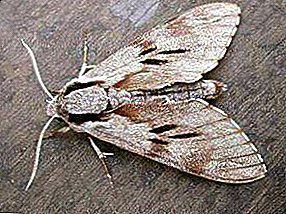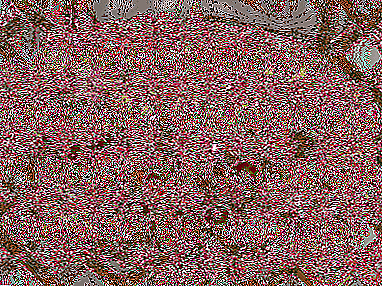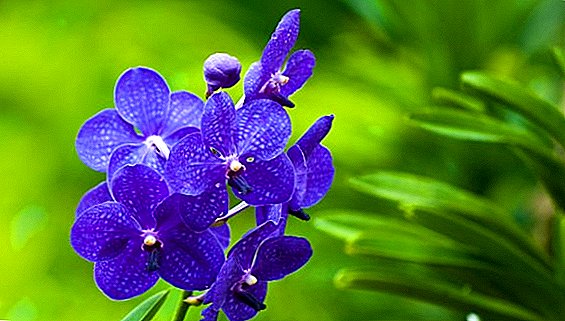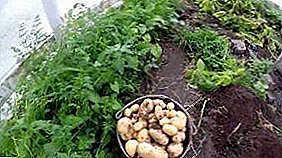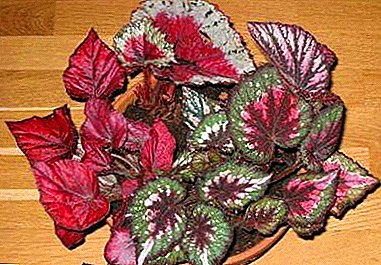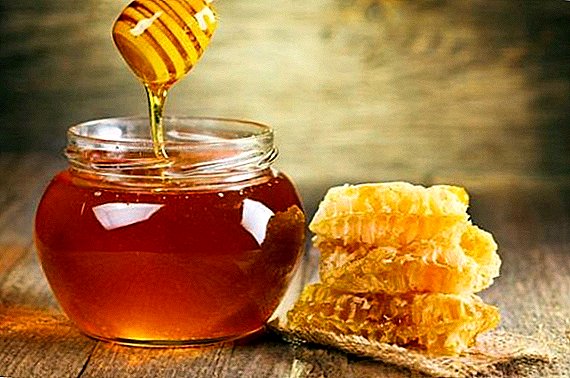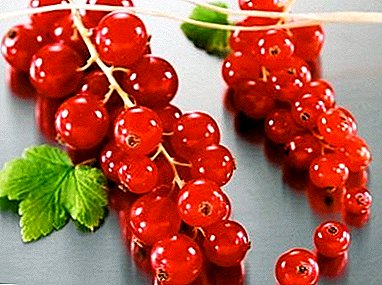
Grade of red currant Beloved Bred recently, but has already managed to captivate the hearts of many gardeners by the fact that, without requiring any special troubles, it presents with a rich harvest not sour, but very tasty and healthy berries.
Description varieties Beloved
Red currant "Beloved" description. A low compact bush of currants, thickly hung with dark red, as if varnished clusters of berries, looks like an exemplary representative of the species.
Shoots it is straight and thick with oblong buds, the young are reddish-purple, and lignified ones are gray.
Leaves this variety resembles "five-fingered" maple - large rough-cloth, devoid of gloss with blunt teeth on the edge. Small tender flowers Beloved appear in the first week of May and remain until the middle of the month, they look like deep yellow-green saucers.
BUT berries - red with dark stripes, soft and juicy, identical in size, are considered almost the sweetest. No wonder their tasting score - 4.8 out of 5. Pleasant sourness in them, of course, is also present.
The average berry weighs 0.6-0.8 grams; there are few seeds under the thin skin. Hanging on the branches, not showered and without losing taste, the berries can be quite long. And retain an attractive appearance even with long transportation.
These berries, excellent in taste, are as if created to make jam from them. It turns out great, especially in combination with summer varieties of apples: Friendship of Peoples, Yellow Sugar, Medunitsa, Orlinka, Golden Chinese, Wonderful, and Hero of the Day.
Breeding history and breeding region
Grade Beloved Bred in the late 1980s in Belarus at the Institute for Fruit Production of the Republican Academy of Sciences.
 The author of the variety is a well-known breeder, Doctor of Biological Sciences Anatoly Grigorievich Voluznev called his brainchild “Beloved” not by accident - the plant turned out to be amazingly beautiful, the eye cannot be torn off from the rich dark greenery, abundantly sprinkled with rubies.
The author of the variety is a well-known breeder, Doctor of Biological Sciences Anatoly Grigorievich Voluznev called his brainchild “Beloved” not by accident - the plant turned out to be amazingly beautiful, the eye cannot be torn off from the rich dark greenery, abundantly sprinkled with rubies.
Three varieties became parents of this currant - Cherry, Wonderful and Dutch Red. All of them gave their "daughter" the best qualities.
Cherry - high yield and presentation of fruits, Wonderful - large and sweet berries, and the Dutch red - winter hardiness and susceptibility to many diseases.
In 1991, the Un-fair was included in the State Register of Varieties of Belarus, and in 2006 it was officially allowed to cultivate in Russia.
Red currant varieties such as Jam, Natali, Andreichenko are successfully grown in these regions. As well as black currant varieties: Gulliver, Gross, Belarusian sweet, Bagheera and Summer House.
Specifications
Grade Beloved differs in high productivity. Young bushes give a little more than 3 kg of berries. With mature, with good care, they remove 10-12 kg. Distinguished Late in late June - early July.
One of the most important advantages of this variety is self-fertility (60%). This means that for the formation of ovaries, it does not need cross-pollination, and does not depend on the weather and the flying of insects - a consistently high yield and so guaranteed.
Frost resistance Beloved is such that it sometimes endures quite severe winters in central Russia without loss for winter without loss.
Berry Beloved contain from 6 to 12% of sugars, a lot of organic acids, tannins and pectin substances, a fair amount of vitamin C - 30.2 mg / 100 g, a lot of mineral salts and carotene. This composition suggests a pleasant sweet-sour taste. Fresh currants of this variety is an excellent dessert, but it is also suitable for jam, and it does not need a lot of sugar to kill the sourness.
You can get a delicious and healing juice from the berries of the Beloved, which has a cleansing effect - it will not only improve the bowels, but also help remove uric acid salts.
And still red currant juice is an excellent diaphoretic, with a cold it helps no worse than honey or raspberry jam.
A photo





Planting and care
- The soil. Grade Beloved grows best on slightly acid loamy well-drained soils enriched with nutrients. Close (50-60 cm) groundwater deposition to the bushes is harmful, in which case the currants should be planted on a small hill.
- Illumination. She loves light, she can be planted in open places - she will prosper there.
- Neighborhood. Red currant "friends" with gooseberries, and "jealous" of her cousin - black currants. All the other garden neighbors do not bother her. The roots of the Beloved lie deeper than those of grassy plants, but higher than those of the trees - so there is no competition.
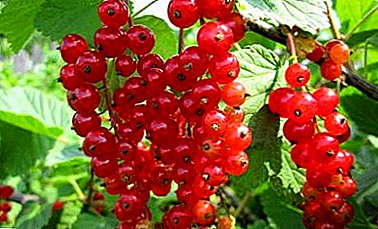 Preparing for landing. Plant red currants need in early autumn.
Preparing for landing. Plant red currants need in early autumn.Two hours before planting, the seedling should be placed in water, preferably enriched "Kornevinom" - then the young plant quickly forms new roots.
Dry or broken roots from the seedling should be immediately removed.
The pit for Beloved needs a depth of not less than 60 cm and a size of 50 × 50 cm. Red currant is a long-lived, it will have to grow in this place for 20 years, and then 25.
So, organic and mineral fertilizers should be put in the pit: chopped branches or chips should be poured at the bottom, then covered with earth, excavated, and added a pound of chalk or dolomite from above.
If there is no chalk, the usual ash from the stove is good - a liter can of ash is enough. There also need to make one tablespoon of fertilizer containing potassium, but without chlorine.
Red currant does not tolerate the presence of chlorine. When choosing a fertilizer for it, give preference to potassium sulfate. Do not lime the soil where it grows - it is worth a little overwork, and the plant will suffer from chlorosis.
In a well filled заполн, add compost and compact all layers by pouring water over them.
Landing
In the middle of the prepared pit they make a mound and, straightening the roots, arrange a seedling in it.
Plant a plant must always be tilted - the three lower buds on the stems should be hidden in the soil, and three or four upper - left above the ground.
Sprinkle sapling soil taken out of the pit. If it is very dense, add sand. It is not necessary to accept and trample the soil around the seedling, but watering it so that the earth can stick to the roots is necessary. If the roots are bare during irrigation, add more soil and water no longer pour.
When planting several bushes need to leave between them at least 1.5-2 meters. Though not a sprawling beloved, the roots need a place, and the bushes need light.
Pruning
When planting shoots seedling cut off pretty short.
It is enough to leave three or four strong buds above the ground, then by the spring of them strong side branches will develop. And from those buds that are buried in the ground, they will go basal shoots.
 After pruning around the sapling, you need to heat up the ground with a height of 10-12 cm. In spring, the bush is broken up and no longer pruned. Over the summer, his branches will grow, and in the fall, when the blowjob is a year, all of them will need to be shortened by a quarter of the length.
After pruning around the sapling, you need to heat up the ground with a height of 10-12 cm. In spring, the bush is broken up and no longer pruned. Over the summer, his branches will grow, and in the fall, when the blowjob is a year, all of them will need to be shortened by a quarter of the length.
In the spring of the second year of life, the seedlings are pruned again - three or four strong, properly growing shoots are selected, and the weak are cut off the ground, leaving no stumps.
In the future, pruning is repeated annually, following the same method. After five years, a dozen strong basic branches should form at the bush.
Branches of 3-5 years old bring the greatest harvest.
Top dressing
Red currant it is undemanding to soil fertility, but loves fertilizing very much - after all, it ripens twice as many berries as black. What was brought into the pit before planting will last for 2-3 years for the bush, and then it will have to be fed. In March-April, Beloved, it is good to "treat" urea - for one bush of 20-25 g.
In May, when the currant blooms, it is watered with a solution of mullein (1 liter of water per 100 g of manure). If you want to increase the yield by 20-30%, spray the currant bush with a solution of boric acid - on a bucket of water - 1.5-2 g. The ovaries will be larger, and large berries will be tied up. This procedure should be done in the evening on a dry day.
Red currant loves mulching - that is, sheltering the soil around substances that replenish the supply of nutrients. As mulch for it, you can take humus, compost, peat, or just phosphate-potassium fertilizers. The height of the mulch layer is 10-15 cm.
Watering
Usually additional watering Beloved not needed. But if in June, when the berries are poured, it is worth drying, the bush should be watered. The same is true in October - if autumn is dry, pour currant.
Water in both cases, you need a lot - 3-5 buckets under each bush. At first, just wet the ground around the bush, and then pour the rest - so the water is absorbed into the soil and goes to the deep roots. You need to water in the evening.
Diseases and pests
Grade Beloved resistant to a variety of dangerous diseases and pests. It does not hit the American powdery mildew (spherotek), anthracnose, bud mite. Fungal diseases do not cause serious harm to this currant. But there are enemies.
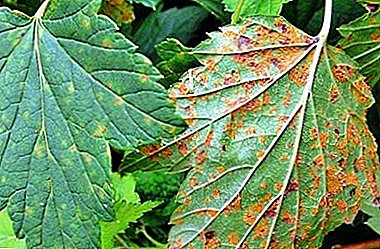 Glass rust - its development is promoted by damp spring, lowland position of currant bushes, especially if a reservoir overgrown with sedge is near.
Glass rust - its development is promoted by damp spring, lowland position of currant bushes, especially if a reservoir overgrown with sedge is near.A mushroom lives on sedge - the source of this infection.
External signs: in the first days of summer, on the underside of leaves, shoots, green ovaries, large yellow pads are formed - fungal spores.
Soon they change shape and become like glasses. Affected leaves and berries quickly fall off, so it is difficult to detect the disease in the second half of summer. With a strong defeat, you can lose half the crop.
- What to do:
- Spray Bordeaux liquid three times (100 g of lime + the same amount of copper sulfate per 10 liters of water). The first time - during the blooming of the foliage, the second - with the appearance of buds, the third - immediately after flowering.
- If there is sedge nearby, it should be mowed and burned either in late autumn or in early spring.
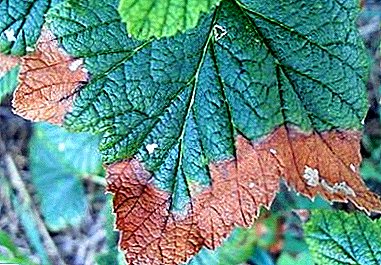 Septoria - it is also called white spot.
Septoria - it is also called white spot.External signs: at the beginning of summer, leaves are strewn with small round spots - brown with a reddish border.
Then they turn white and black dots appear in the middle of the spots. The leaves dry and crumble.
What to do:
- Before the appearance of flowers and after harvesting, treat the bush with Bordeaux mixture or biopreparations "Zircon", "Fitosporin".
- In the autumn to collect and burn the fallen sick leaves - pests spend the winter on it.
As for the most common diseases of horticultural crops, you can read about them in detail in the articles of our website: anthracnose, chlorosis, bacteriosis, rubella, bacterial cancer, //selo.guru/ptitsa/bolezni-p/gribkovye/parsha.html, rust .
Modern varieties of red currant, which include Beloved, compare favorably with those that have long been known - both because they are not afraid of frost, and because they are resistant to pests, and by the wonderful taste of berries, which contain no less sugar than black currant fruits.


 Preparing for landing. Plant red currants need in early autumn.
Preparing for landing. Plant red currants need in early autumn. Glass rust - its development is promoted by damp spring, lowland position of currant bushes, especially if a reservoir overgrown with sedge is near.
Glass rust - its development is promoted by damp spring, lowland position of currant bushes, especially if a reservoir overgrown with sedge is near. Septoria - it is also called white spot.
Septoria - it is also called white spot.